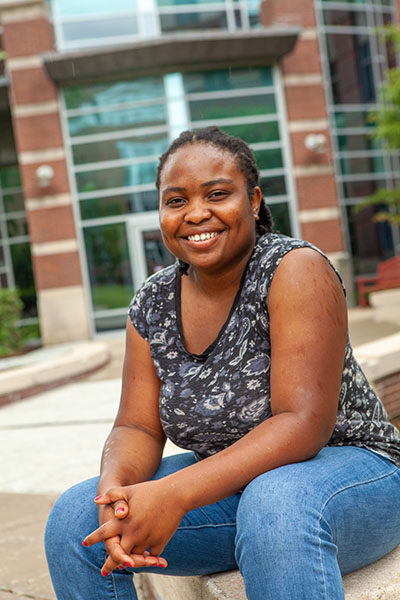- Apply
- Visit
- Request Info
- Give



Published on August 31, 2022
Two Eastern students spent their summer’s completing research fellowships under close faculty mentorship. Senior History major Elizabeth Bartoshevich continued a digital history project connected to her honors thesis, and junior Biochemistry major Djenerly Massena completed a computational chemistry project, which she also presented at a national conference.
History Professor Jamel Otswald mentored Bartoshevich’s project and Physical Sciences Professor Kedan He mentored Massena’s work. In order to receive the Undergraduate Research and Creative Activity Fellowship, students must carry a 3.0 GPA. In addition to the one-on-one mentorship, students receive a $1,000 stipend and $250 for project expenses.
Elizabeth Bartoshevich
Titled “A Digital History analysis of Narcissus Luttrell's A Brief Historical Relation of State Affairs 1678-1714,” Bartoshevich’s project involved analyzing a large document from early-modern England, detailing all of the pieces of news Luttrell encountered on a weekly basis. “I am examining the complex news network around Luttrell by analyzing the thousands of entries with natural language processing tools (Python) and combining this with traditional historical research methods.
“Because of the volume of information, this research requires the use of coding to answer the question of how Luttrell experienced, categorized, and understood the world of news around him. This news came from around the world, so the analysis requires geolocating and mapping to be understood.”
Bartoshevich said due to the digital nature of her research, she wants to create a website that would function as an interactive database to explore the data and showcase the research. “This website would serve as a way to disseminate various research projects, be a great e-portfolio asset to my graduate school applications…and would be more accessible to the general public.”
“This is an ambitious project which combines traditional historical research in uncovering the mindsets of past societies with the use of cutting-edge tools for the digital humanities,” said Otswald. “Liz has shown her aptitude with computers and is applying various Python programming libraries to analyze the text and metadata.
Along with the big picture, the variety of topics will also allow her to focus in on a single topic of interest. Although History honors theses have traditionally been research papers, a digital history project like this obviously shouts out for a web presence, which could even be used by other scholars who would like to explore Luttrell’s relation more systematically.”
Djenerly Massena

Massena’s project was titled “Unsupervised Ensemble Learning Using High Dimensional Spectroscopy Data of Organic Compounds.” According to Massena, the continuing emergence of new psychoactive substances (NPS) is a threat to public health and requires immediate attention to more effectively predict and identify the emergence of new NPSs.
“A range of machine learning-based multivariate analysis techniques have been shown to be suitable for chemical spectroscopy data, such as unsupervised analysis,” said Professor He. “The issue is that high-dimensional data like spectroscopic data is challenging for clustering, and different ways of looking at the dataset and clustering parameters can lead to diverse/different clustering solutions. This brings in the cluster ensemble method. It solves the challenge of choosing an optimal clustering algorithm by computing a final (consensus) solution using a set of clustering solutions that can achieve a better performance than the traditional cluster ensemble method.”
Massena explained clustering: “It is the grouping of objects that are (most) similar to each other and those that are (most) dissimilar to each other into another group. It is a widely used data mining technique to analyze large molecular databases. Let's say we were grouping colored circles into two squares; all the red circles go into square number one along with all the other colors that are close or similar to red such as pink. the remaining circles colored different shades of green or other colors similar to green go into the second square. To conclude, all objects within square one are most similar to each other and yet dissimilar to all the objects in square two. That is clustering.”
During the summer, Massena and He investigated and evaluated different cluster ensemble selection strategies to further reduce the set of base clustering solutions to form the final consensus solution and can still compete with the full ensemble approach.
Massena presented their research at the 2022 MERCURY conference at Furman University. MERCURY stands for the “Molecular Education and Research Consortium for Undergraduate Computational Chemistry,” of which Professor He is a faculty member.
During the MERCURY conference, Massena also participated in a workshop on electronic structure calculations, using PSI4 software and Jupyter notebooks offered by the Molecular Sciences Software Institute, where Professor He served as one of the instructors this year.
“We were introduced to new ways of coding with Python and best methods on use of GitHub as well,” said Massena. “I also had the chance to present my work, learn from my peers' projects, and build connections (with people) from across the country that will undoubtedly help me throughout my lifetime. The speakers were quite eloquent, and it all ended with me appreciating the opportunity given to me by my mentor, Dr. He, the professors, and the staff that made this experience nothing short of excellent.” Massena’s research is currently being reviewed for publication in a professional journal this fall.
“Throughout this process, Djenerly learned how to communicate her research activities to be understandable to a general audience,” said He. “She was embraced at the MERCURY Conference, where fellow undergraduate students are also engaged in computational chemistry research, bolstered her confidence and inspired her for future pursuit in medical or graduate school. This research project was a perfect fit for her.”
Written by Dwight Bachman